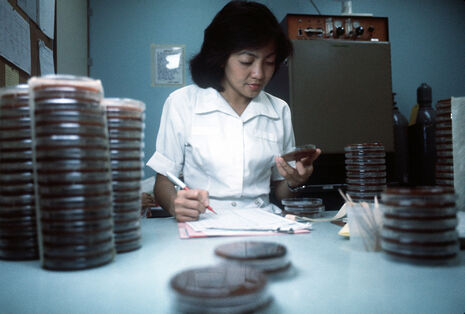Girls need to know that it’s OK to study science
Emily Fishman wants a world where girls don’t feel embarrassed to study traditionally ‘male’ subjects

We all like to see our society as one in which any self-identifying woman can achieve her hopes, ambitions and aspirations. With recent empowering campaigns such as This Girl Can and the recent success of female Olympians at Rio 2016 – Laura Trott and Simone Biles scooping up gold – we are made to believe that girls can achieve greatness.
But I often find these images from the press misleading. Not only are they unrealistic (not everyone is an Olympic gold medallist), but they also make turn a blind eye to the inequality around us.
One such example which resonates strongly with me is the lack of female scientists. From a young age, science always fascinated me. I loved learning about the body: dissecting sheep’s hearts, experimenting with Bunsen burners and understanding Newton’s laws of physics.
Yet as the years passed by, it became more obvious to me that chemistry and physics were male-favoured subjects, along with maths and further maths. Girls seemed to prefer the arts, especially English literature and media studies.
The subject gender gap seemed the widest and most obvious in Year 12. At A-level, the physics class had a pitiful two girls out of a class of 20. Chemistry didn’t fare much better, with two thirds of the class male, and just one third female. Biology was in fact better represented: nearly half of the class was female. But then, biology is often considered to lie at the more ‘feminine’ end of the science spectrum.
One could deduce from this that men are, to a degree, under-represented in some of the arts subjects, but looking at higher education, this is not the case at many UK universities. Meanwhile, in subjects such as Chemical Engineering, Computer Science, Maths and Physics, girls are the small countable minority.
What bothers me is how discouraged I was back in Year 12 from studying a science. At the vulnerable age of 16, we all feel inclined to fit a mould, or be seen as ‘normal’. In my case, I felt that, as a girl, I should be studying an art or humanities option.
The feeling of being put off a subject because of your gender is one of the very real reasons why so many girls don’t apply to study science at university. Often, those girls who do have come from all-girl schools. But we cannot rely on single-sex schools to do the work in bridging the gender gap.
This problem presents an access issue for British universities across the country. Cambridge is no exception. Last month, Robinson College held its second annual Women in Science event, open to Year 12s and 13s.
The event was a success, showcasing the work of lots of female scientists – everything from metal alloys to marine biodiversity. The girls also got to experience hands-on practicals and subject taster sessions run by the various science faculties.
Seeing the sheer delight and fascination on their faces as they watched, learnt and took part in the activities was a rewarding and satisfying experience. The sense of inclusion and spirit of ‘girl power’ made the event a real triumph.
When the lack of female scientists is raised in the press, the blame is often pointed at universities. Universities often blame schools, and schools blame the government, while the government blames teachers.
Ultimately, no one is directly to blame for the lack of equality in the sciences – societal roles and structures are the decisive forces at hand. Until young girls can feel accepted and celebrated for studying science, the gender gap will always be there.
 News / Uni Scout and Guide Club affirms trans inclusion 12 December 2025
News / Uni Scout and Guide Club affirms trans inclusion 12 December 2025 News / Pembroke to convert listed office building into accom9 December 2025
News / Pembroke to convert listed office building into accom9 December 2025 News / Cambridge Vet School gets lifeline year to stay accredited28 November 2025
News / Cambridge Vet School gets lifeline year to stay accredited28 November 2025 Features / Searching for community in queer Cambridge10 December 2025
Features / Searching for community in queer Cambridge10 December 2025 News / Uni redundancy consultation ‘falls short of legal duties’, unions say6 December 2025
News / Uni redundancy consultation ‘falls short of legal duties’, unions say6 December 2025









